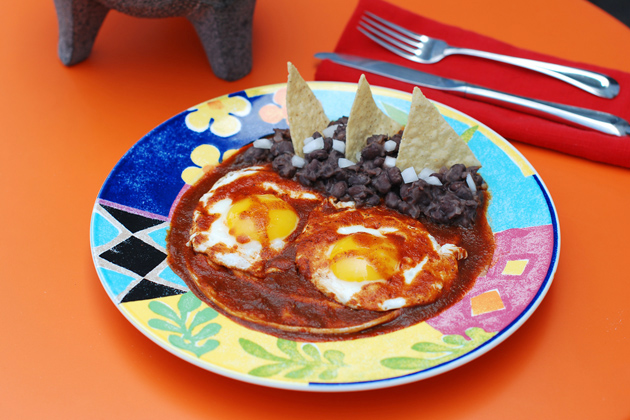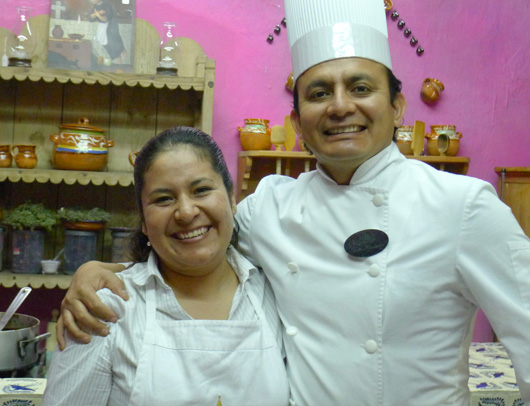The sun-drenched pink walls in the central court at Mesones Sacristía were too much for my early morning eyes. We ducked from the brightness into a quiet room to one side and slipped into a fug of half-sleep, slaking the cotton of jetlag with coffee. Maurice raised an eyebrow at the sunglasses I’d donned against the glare and held his pencil ready.
‘Huevos Rancheros? Si, senor. Un momento por favor.’
As we’d been quick to discover, Puebla’s crisp clear air, centuries-old culture and hip and happening feel more than made up for any lack of beaches in the vicinity. Wandering the European-style districts of this city set in mountains between Mexico City and Veracruz, we nibbled on street food and dined with Mexican tourists in the square. But this day was different: now it was time to learn.
From a little kitchen behind the hotel’s main desk, Chef Alonzo Hernandez and his friendly assistant Liz taught us over three days more than I ever expected to know: about chilies, cooking techniques, and the sauces and spices of Mexico. Soft-spoken Chef Alonzo, casually capable and precise, was more than up to the task. Considered one of 3 or 4 top chefs in this food-centric city, he brought to the table his unerring culinary wisdom. He and Liz changed our minds forever about Mexican foods.
After those classes, I can never again look at a chili pepper the same way. How it’s dried or smoked matters so much that the same pepper can end up with many different flavors. And then in cooking, whether a chili is dry-fried on a comal, fried in oil in a pan or reconstituted with hot water gives another dimension as well. And how dark a chili’s allowed to get when first dried or later cooked determines its intensity in the final sauce. One sauce made in his restaurant utilized a special pepper that was slowly dried until medium-brown and then treated with liquid smoke to impart its characteristic flavor. As far as Chef Alonzo and Liz knew, there was no other chili and no other sauce like it anywhere.
Meanwhile, my favorite breakfast arrived with a slight smile from Maurice. The vivid spicing on the eggs perked up my taste buds. The dish’s main event was another of the great sauces that came from Chef Alonzo’s kitchen, perfectly balanced. ¡Buen provecho! Here’s my take on it.
;
Huevos Rancheros the Puebla way
Makes 2 cups of sauce, enough for 4 servings
For the sauce:
8 roma tomatoes, about 1½ pounds, cut in half lengthwise
1 Ancho chili pepper, stemmed and seeded
1 Chipotle chili pepper, left whole
¼ of a large white onion
1 large clove garlic
¾ teaspoon salt
1¼ cups of hot water
For each portion:
2 lightly fried white corn tortillas
½ cup of sauce
2 eggs fried as desired
Refried beans and tortilla chips to garnish
Cooking note: The authentic way to cook the ingredients for this sauce is by dry frying them on a comal, which is a flat piece of 16-gauge steel with raised edges and a little handle. Very simple, but it works. Alternately, use an uncoated metal frying pan, but resist the urge to add oil. Also, do not use a Teflon-coated pan for this step as it is unsuitable for this type of cooking.
Dry fry the sauce ingredients: Cut 8 roma tomatoes in half lengthwise; cut ¼ of a large white onion crosswise in half and separate the segments; peel a large clove of garlic and cut into two pieces; and remove the stem and seeds from a large Ancho chili and tear it into four flat pieces.
In two batches, dry fry these and the chipotle chili over medium high heat on a comal, turning the pieces often with tongs to lightly char all sides. I find it easiest to cook half the tomatoes and all of the other ingredients at once, when the comal needs the most attention, and do the rest of the tomatoes second. As various pieces become limp and cooked through, remove them to a bowl. (The ancho chili will cook fastest, and then the garlic, onion and chipotle chili, while the tomato will take as long as 10 minutes.)
Make the sauce: Put the finished pieces in a blender or food processor, add ¾ teaspoon of salt and 1 cup of the water, and pulse until smooth. Add the other quarter cup of water if the sauce is too thick – this depends on the juiciness of the tomatoes. Now liquidize for about 30 seconds.
Put the sauce through a fine sieve to remove seeds and skins. You should end up with about 2 cups of thin sauce and 1 cup of discarded pulp.
Arrange the plate(s): Lightly fry 2 tortillas per serving. Heat refried beans in a small pan. Fry two eggs per serving, preferably sunny side up in the Poblano way. Spread 3/8 cup of sauce under and around the tortillas and put the eggs on top. Spread a couple of tablespoons of sauce over the eggs. Garnish with refried beans and tortilla chips and serve hot.
To see photos of the cooking classes we took in the beautiful city of Puebla, click Here. And if you’re interested in taking your own cooking classes, contact Liz at Mesones Sacristía and she’ll be happy to make arrangements. Just be sure to tell her Sortachef sent you!




Ancho and chipotle?!?!? WOAH! Sounds great!
Huevos rancheros is my most favorite breakfast meals. When I make it I like to add in some potatoes– like hash browns or home fries.
Of course we all want to head to these classes Don. A few days in Mexico would be so welcome right now!
beautiful food this looks wonderful Don
I’m so glad you liked the mexican food 🙂 , I’m from mexico, and I feel we have a lot of food to offer 🙂
I hope you enjoy your time there 😀
love your blog 😀
Wow that looks really goooood! Especially the sauce…mmmmm!